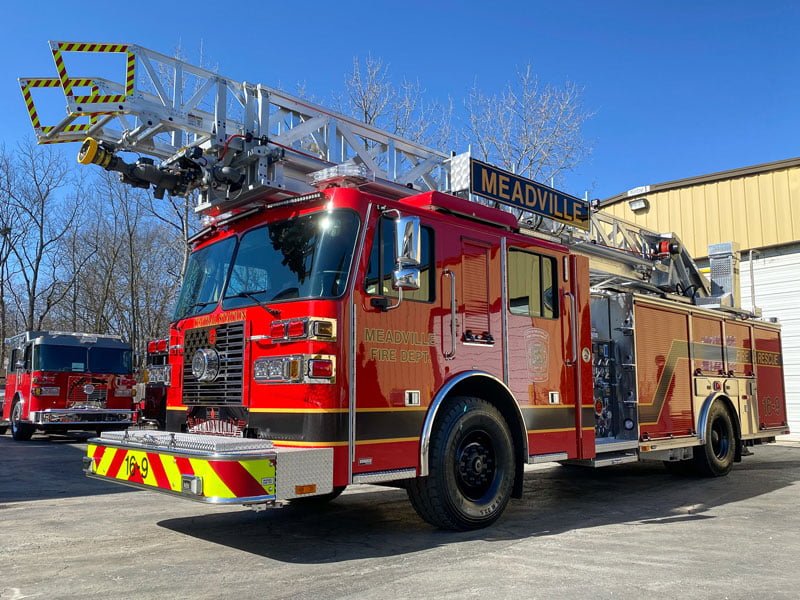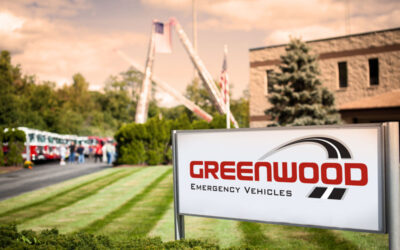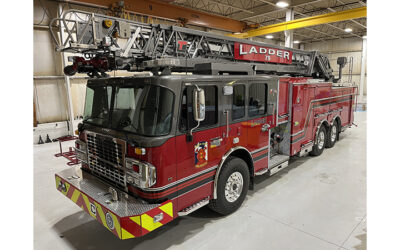By Alan M. Petrillo
Meadville (PA) Fire Rescue & EMS had a 30-year-old aerial platform and a pumper that were starting to have maintenance issues, so the department put together a truck committee to spec out a quint that could fill the functions of both an engine and a truck. At the end of the committee’s work, the department decided to purchase a Sutphen SLR 75 quint aerial ladder.
Patrick Wiley, Meadville’s chief, says, “The maintenance was starting to get to us on our 31-year old Grumman Firecat pumper and 30-year old Sutphen aerial platform, so we approached the city council and city manager about starting the replacement process, and they agreed.” Wiley formed a truck committee consisting of two senior firefighters, two mid-range firefighters, and two younger firefighters to spec out a quint that could serve the department in current times and the foreseeable future.
“We got rid of the Grumman pumper and decided to keep the Sutphen platform as a reserve truck,” Wiley points out. “Sutphen’s trucks hold up great and their lifetime warranty on the frame is a bonus for us with weather like we have in northwestern Pennsylvania.”
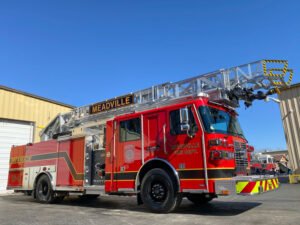
The Sutphen quint for Meadville has an Elkhart Brass Company 7205 Cobra EXM electronic monitor and SM1500 nozzle at the ladder’s tip.
Andy Kilmer, salesman at FAST of the Allegheny Mountains, who sold the quint to Meadville, says the SLR 75 aerial ladder quint is built on a Sutphen Monarch heavy duty custom chassis with a four-door 62-inch flat roof extended cab with seating for five firefighters, three of them in SCBA (self contained breathing apparatus) seats. Kilmer says the rig has 110,000-psi (pounds per square inch) 10-inch double Domex frame rails, a 23,000-pound front axle suspension, a 35,000-pound rear axle suspension, powered by a 450-horsepower (hp) Cummins L9 diesel engine, and an Allison 3000 EVS Gen 5 automatic transmission, with a Leece Neville 420-amp alternator.
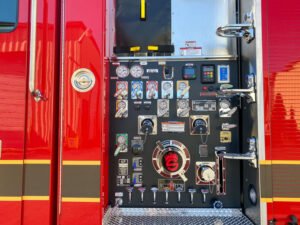
Meadville’s quint has a Hale Qmax 1,500-gpm single stage pump and a 500-gallon water tank.
Kilmer notes the aerial ladder’s body is 304 Huckbolted stainless steel with more than 185 cubic feet of compartment space, Amdor roll-up compartment doors, and a ladder tunnel holding a Duo-Safety ladder package of a 35-foot three-section extension ladder, a 24-foot two-section extension ladder, a 16-foot roof ladder, and a 10-foot folding ladder.
Wiley says the quint has a Hale Qmax 1,500-gallon per minute (gpm) single-stage pump, a 500-gallon water tank, an Elkhart Brass Company 7205 Cobra EXM electronic monitor with a SM1500 nozzle at the tip of the ladder, 150-feet of 1-3/4-inch hose in a covered hose well in the 24-inch extended front bumper, two 200-foot 1-3/4-inch hose cross lays, and one 200-foot 2-1/2-inch cross lay above the pump panel.
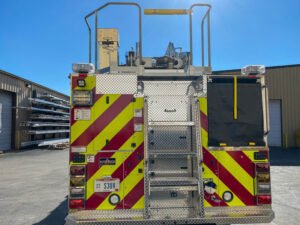
The rig’s side-stacker hose bed carries 800 feet of 4-inch LDH (large diameter hose), 400 feet of 2-1/2-inch hose dead lay, 200 feet of preconnected 2-1/2-inch hose tipped by a Task Force Tips Blitzfire nozzle, and 300-feet of preconnected 1-3/4-inch hose for reaching set-back structures.
Wiley points out that the quint’s hose bed is carrying 800 feet of 4-inch LDH (large diameter hose), 400 feet of 2-1/2-inch hose dead lay, 200 feet of preconnected 2-1/2-inch hose tipped by a Task Force Tips Blitzfire nozzle, and 300-feet of preconnected 1-3/4-inch hose for reaching set-back structures. He adds the rig also carries an oil dry hopper, a battery operated combi tool, battery powered DeWalt saws and drills, and an RIT (rapid intervention team) bag.
Kilmer says the quint has a grill-mounted Federal Q2B siren, a FRC ACT two-station intercom system, and a FRC InView True Sight single camera system. Lighting on the rig includes a Whelen LED FNMINI light bar, a Hi Viz Fire Tech three-piece 72-inch LED brow light with integrated ICC lights, Hi Viz Fire Tech LED 12-volt flood and scene lights, Hi Viz Fire Tech LED Laser Cannon lights, and Hi Viz Fire Tech LED boom spot lights.


